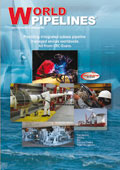Editorial comment
As news of next year’s royal wedding keeps the UK, and the rest of the world, speculating about dates, dresses and "I dos", it’s interesting to see how public opinion swings in the face of what will be a huge event for the British establishment in 2011. Royalists will love a good show of pomp and circumstance, the anti-monarchists will decry the public expense and constant media coverage, but I suspect that most people will take an amused, good-natured interest in the whole production.
Register for free »
Get started now for absolutely FREE, no credit card required.
Given all this, I think our Prince and his future Princess would do well to show some sensitivity towards the current economic hardships being experienced by many around the world, perhaps by reining in some of their more extravagant royal wedding expenditure.
A big flashy wedding in a weak economy is much like ambitious pipeline construction plans in a cheap gas market: no one wants to spend the money in the current climate.
This week I read a report about the European Autumn Gas Conference (EAGC), which took place recently in Berlin. Stefan Nicola, writing for the European Energy Review, describes the self-image problems of the European gas industry, an industry that, he says, “feels unable to shoulder large infrastructure projects as markets remain fragile”.1
He argues that even with European markets looking to be on the rebound, oversupply problems mean that everyone is hesitant to invest in gas infrastructure.
Despite European Commission visions of more pipelines in order to diversify supply and ease bottlenecks - with a goal of ensuring that every EU region has access to at least three different sources of gas - the cost of construction could come down to the industry itself, which is understandably hesitant to pour money into a sector where gas makes much less profit than oil.
The Commission has outlined where it believes the gas sector could develop in the EU and this includes more pipelines linking the Baltics to western EU markets; a southern corridor gas pipeline feeding Caspian gas to Europe; and a north-south gas pipeline to help ease bottlenecks in western Europe. This is in aid of reducing European dependency on gas from Russia and freeing-up the network so that gas and LNG can be bought and sold across the continent.
However, with consumption down following the financial crisis, with gas stores high, and investment being made in renewables rather than natural gas, it’s not surprising that the European gas industry is wary.
In the US, the picture is much the same, with low demand, record inventory levels and strong supply growth keeping prices down in comparison to oil.
So what’s in store for the European gas market? Will slowing the pace of new supply bring prices back up and spur new construction projects that will ensure safer and more reliable delivery? Will the increasing gasification of power generation mean that oversupply ceases to be a problem? And how will the competition between the Nabucco pipeline and the South Stream pipeline pan out? World Pipelines has been following each project since it was proposed and by all accounts emotions ran high at an EAGC panel to debate southern corridor pipelines. Whatever the new year brings, European Commissioner Gunther Oettinger was keen to stress at the EAGC that gas is of vital importance to the energy mix in Europe and that it would remain so “for decades to come”. If ever the gas industry needed a solemn vow of support, it’s now.
1. NICOLA, STEFAN, ‘Europe’s gas industry deeply divided over the future’, European Energy Review, 22nd November 2010.


